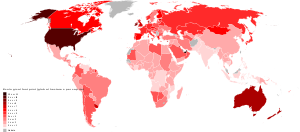Is Eco-Efficiency a Sufficient Strategy for Achieving a Sustainable Development? The Norwegian Case (16 page pdf, Sustainability 2010, 2, 3623-3638, Nov. 24, 2010)
From the nation whose Prime Minister (Bruntland)brought us the concept of “sustainable development” comes an article which examines the extent to which the environmental impact of consumption outweighs gains in production efficiencies. As an aside, a similar situation seems to exist in the US and Canada in the incremental increase in energy efficiency/gas economy of automobiles which is outweighed by the growth of urban sprawl which, in turn, accelerates the need to drive farther in the daily commute, resulting in greater overall vehicle emissions and degraded urban air quality. Recommendations include a need to monitor consumption with a comprehensive index such as the ecological footprint, recognizing its limitations as a policy tool or “A Consumption-Oriented Environmental Policy”

Key Quotes:
“We challenge the notion that subjecting production processes to eco-efficiency measures is sufficient for reducing the overall environmental impact.. rising consumption rates eliminate the bonus of eco-efficiency in production.”
“A radical shift in the Norwegian way of life in a more climate-friendly direction could deliver major reductions in future GHG emissions. The Commission on Low Emissions has, nevertheless, chosen not to recommend such a strategy, because, among other things, we believe it would be politically impossible to put into effect”
“What the data shows, is an indication of increased eco-efficiency in Norwegian production.
- 39% reduction in fuel consumption per person-kilometer in air travel abroad;
- 20% reduction in energy consumption per square meter of housing area;
- 10 to 30% reduction in energy consumption per ton of construction materials produced;
- 26% reduction in farmed area per kilogram of cotton; and
- 19 % reduction in farmed area per kilogram of wheat (29).
Still, .. these improvements have partly been outweighed by an increase in the total amountof production”
“GHG emissions increased as a result of several developments:
- person transport by Norwegians increased by 60% for all means of transport. ..Regular air transport abroad accounted for 38% of the total increase in person transport.
- consumption of commodities other than food has increased…money spent on clothing and shoes increased by 147%..money spent on furniture and household equipment increased by 87%”
“major adjustments suggested:
- A specific consumption focus in environmental policy should be developed, beginning with the consumption categories with the largest footprint (volume) and the most negative development (change)
- The environmental impact of consumption should also be monitored as part of the official sustainability indicator monitoring system, e.g., by calculating the ecological footprint
“Our point is that we need an increased focus on the consumption side, and that using EF is one of many possible positive contributions in doing so”
Related articles
- KONE Launches "10 for 2010" Eco-efficiency Challenge (eon.businesswire.com)
- Cloud computing to cut 38% of data center energy costs by 2020: Pike Research (newstatesman.com)
- Climate change conference begins today in Cancun (thehindu.com)
- Infographic: Energy Consumption By State (How Embarrassing) (blisstree.com)
- World Bank Cuts U.S. GHG Emissions 7%, Paper Use 15% (environmentalleader.com)
- The Challenge of Greening IT | Snurblog (snurb.info)
- Alex Becker: Life After Sprawl: Why the Green Revolution Must Start in Suburbia (huffingtonpost.com)
- The Staples 2nd Annual Global EcoEasy Challenge Expands to Include University Students Worldwide (eon.businesswire.com)
- [berkman] Juliet Schor on sustainability and the Web (hyperorg.com)
- Ecoffee - contributing to balance of ecology, equity, economy (carpediemclub.wordpress.com)
- Green Business Bureau Helps Businesses Go Green (eon.businesswire.com)


No comments:
Post a Comment